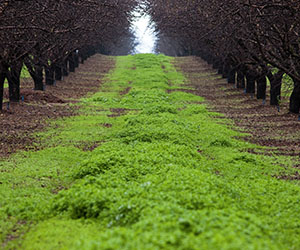The idea of planting cover crops in or around an orchard can raise eyebrows among California almond growers because of certain unknowns about the practice and/or perceptions around how cover crops interact with and impact resources for almonds themselves. When harvesting, for instance, growers are looking to have a clean, bare orchard floor. During dormancy, growers do all they can to prevent frost damage. And year round, water is an essential resource that many growers feel they cannot afford to put towards anything besides their trees.

However, preliminary research is starting to bust myths and unveil the possibilities and benefits of planting cover crops.
A team of Almond Board-funded researchers are entering their third year of cover crop trials in commercial orchards. Led by Amélie Gaudin, assistant professor in the Department of Plant Sciences at UC Davis, the team is looking to learn about a variety of impacts that cover crops may have on almond orchards and trees. Currently, the team is testing two different cover crop mixes: a “soil mix” that is composed of 10% Bracco white mustard, 10% Daikon radish, 30% Merced ryegrass, 20% Berseem clover and 30% common vetch, and a “pollinator mix” that is composed of 15% Bracco white mustard, 20% Daikon radish, 15% Nemfix yellow mustard, 15% common yellow mustard and 35% canola.
In addition to collecting data on improvements in soil properties, water infiltration, etc., the team is working with Neal Williams of UC Davis to determine how cover crops impact pollination and bee visitation to almond blossoms, and also with UC Riverside’s Houston Wilson to determine if cover crops may assist in winter sanitation and navel orangeworm mitigation throughout the year.
“We’re conducting this research in three different orchards in three different counties — Tehama, Merced and Kern — which allows us to evaluate different cover crop mixes and compare the benefits and potential tradeoffs with bare orchard floor,” said Gaudin.
Initial research findings demonstrate a potential slew of benefits to cover crops use, including improved soil health and soil structure, improved water infiltration, effective suppression of weeds and a suppression of pests such as parasitic nematodes. (All these benefits will be explained in detail in future ABC articles, so stay tuned!) In the meantime, growers are encouraged to reference a one-page research summary of Gaudin and team’s findings that was presented at The 2018 Almond Conference last December.
With this broad collection in data comes findings that directly relate to grower concerns around cover crops, namely, during this time of year, questions about harvesting over cover crops in the center of orchard rows. According to Gaudin, most growers interested in implementing cover crops on their operation will choose a seed mix that they will plant at the end of October and which will grow throughout the winter, then terminated by mowing and spraying right after bloom. This guarantees there will be little-to-no residue in growers’ orchards by the time harvest rolls around.
“After two and a half years of research we’ve found there’s misconceptions around cover crop residues and the harvesting process, as spring mixes have plenty of time to die off before harvest begins,” said Gaudin.
A variety of questions may still remain in a grower’s mind — how do cover crops impact winter sanitation, do these crops supplement pollination during bloom, etc. The good news is that Almond Board-funded research will continue to explore these questions and report findings out to the industry.
For now, growers are encouraged to take existing research and plant a small section of cover crops in their orchards.
“There are certainly opportunities for cover crops in almond orchards that growers should explore, but growers need to understand their soil type, water availability and other key factors before selecting and planting any cover crop soil mix,” said Gabriele Ludwig, director of Sustainability and Environmental Affairs at the Almond Board.
Gaudin agrees, and she recommends growers try different cover crop seed mixes on a small surface area at first to determine which plant species and combinations work best in their orchards: “Take a diagnostic of your orchard and try different cover crops to determine which provide you with the greatest solutions for your greatest problems at the best price.”
Growers interested to purchase cover crop seeds mixes are encouraged to visit Project Apis m.’s website to learn more about their Seeds for Bees® program. This program looks to “increase the density, diversity, and duration of bee forage in California orchards, farms and vineyards, while improving soil health and supporting good land stewardship,” and enrollees will receive free or subsidized cover crop seeds designed by Project Apis m., along with technical support. Click on the following links for more information on various seed mixes and guidelines to enroll.
Growers are also encouraged to provide feedback on how they think cover cropping could help meet needs in their orchards through an ongoing UC Davis survey that will supplement Gaudin and team’s ongoing research. The objective of this survey is to understand growers’ motivators and barriers of cover crop use, as well as to better understand the management practices of those who are utilizing cover crops on their operation. Growers may click this link to complete the five-minute survey.
Stay tuned for more “In the Orchard” articles on cover crop research, newly discovered benefits and grower testimonials.



